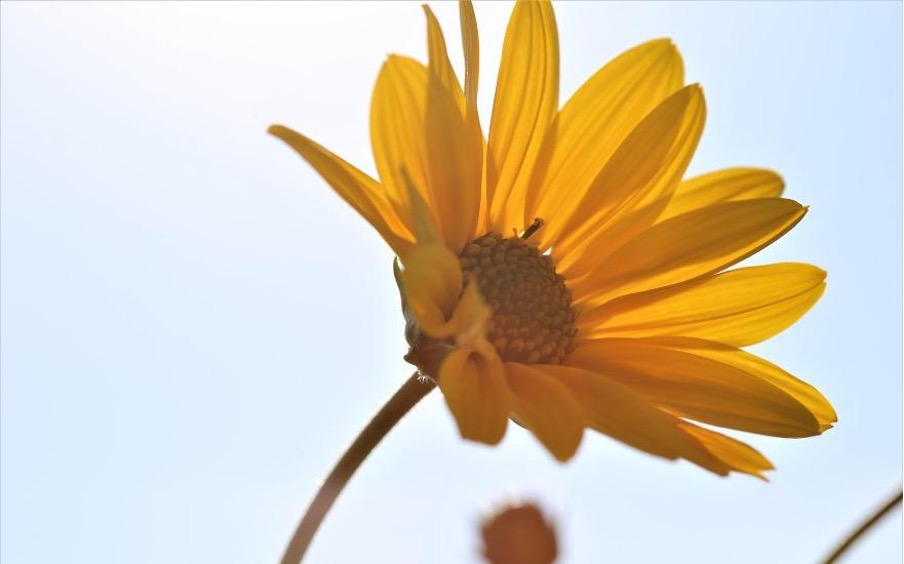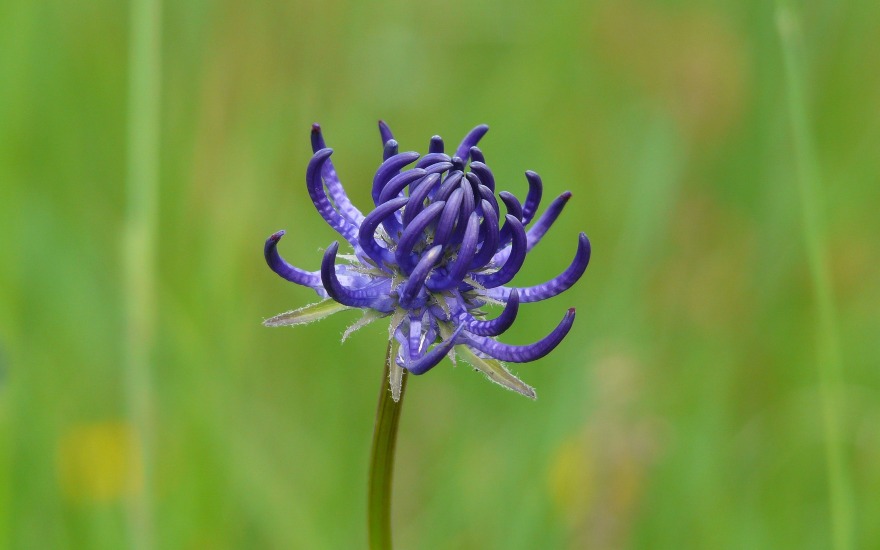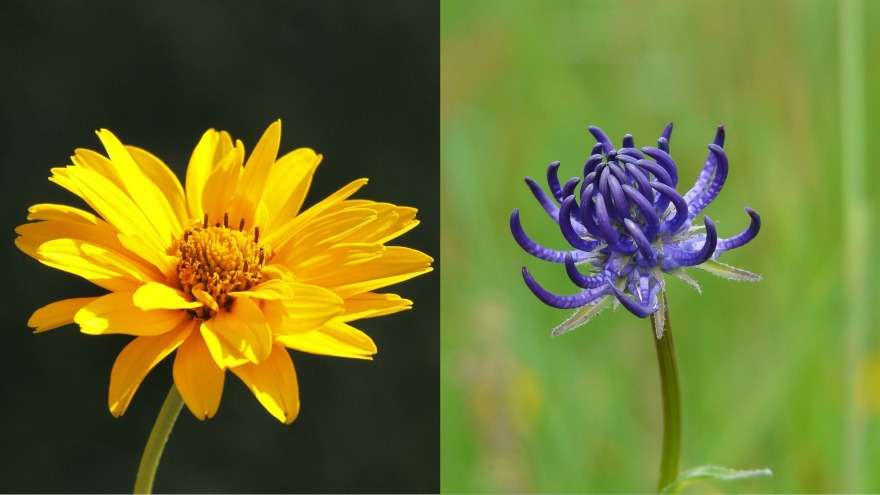Here’s when to choose devil’s claw or arnica products
Arnica and devil’s claw are two well-known herbs in natural medicine, so much so that many people use products made from these plants as an aid against neck, back and joint pain and many other problems.
But is it better to use arnica or devil’s claw? Are they equivalent remedies or not?
In this article, we will explore the active ingredients, benefits and uses of both plants, and compare them so that you know when to choose one over the other.
What is arnica and what are its benefits?
Arnica montana is a herb belonging to the Compositae family (also called Asteraceae) that has been used since the 16th century to reduce pain and inflammation.
The stem can reach a height of about sixty centimetres, and the daisy-like flowers are bright yellow.

In nature, it grows mainly in the mountainous areas of Europe – in fact, it is called the ‘mountain daisy’ – but nowadays, its cultivation is particularly widespread in order to make full use of the flowers’ therapeutic properties.
Arnica flowers are rich in functional active ingredients, e.g. flavonoids, polyphenols, carotenoids, sesquiterpene lactones and many other substances.
Many of these components interact with our organism, bringing numerous benefits. In particular, thanks to them, arnica has the following properties:
- anti-inflammatory
- pain-relieving
- antioxidant
- protective of microcirculation
- revulsive
Read the following article to learn more: Arnica: what it is, what it is used for and what are its properties
The uses of Arnica Montana
Numerous products are made from arnica flower extracts and water, including arnica gel, creams, oils and sprays.
Several studies (such as the following: Clinical Trials, Potential Mechanisms, and Adverse Effects of Arnica as an Adjunct Medication for Pain Management) have successfully tested the use of preparations for cutaneous use against muscle and even joint pain.
In the course of the research, the continued use of arnica products was found to be particularly effective against back pain, neck pain, muscle strains, contusions, swellings, bruises (bruises) and joint pain.
It is also possible to find homeopathic products for oral use based on extracts of the plant on the market, but their efficacy is doubtful.
In fact, arnica, if ingested, is toxic to the organism: products for oral use may contain its extracts, but only if they are abundantly diluted, thus detracting from the product’s effects.
Let us now see what devil’s claw is and what its uses are.
What is devil’s claw?
Devil’s claw (Harpagophytum procumbens) is a perennial plant that grows mainly in western and southern Africa. It gets its very distinctive name from the shape of its sharp purple fruits, which resemble hooks.

Parts of the plant, such as the roots, are rich in flavonoids, triterpenes and phytosterols, substances with anti-inflammatory, pain-relieving and antioxidant properties.
For this reason, devil’s claw has been used for centuries in traditional African medicine against numerous joint, muscle and even digestive problems, but its use and cultivation is now widespread throughout the world.
Benefits and uses of devil’s claw
Devil’s claw extracts are mainly used to produce dietary supplements and preparations for skin use, such as gels, creams and ointments.
Specifically, supplements based on this plant are intended for the function of joints and the digestive system.
For example, many people take devil’s claw supplements as a natural anti-inflammatory against pain caused by arthritis and osteoarthritis or to aid digestion.
Devil’s claw gels, like creams and other topical products, on the other hand, are very popular for relieving joint and muscle pain. It seems that applying these products to the affected areas helps reduce discomfort and tension.
But which product to choose between arnica and devil’s claw?
Arnica or devil’s claw: which one to use according to the different problems?
Both plants are rich in anti-inflammatory and pain-relieving active ingredients, but there are differences.
Arnica is recommended as an aid against the following problems:
- hematomas and bruises
- sprains
- contusions
- back pain
- muscle cramps and strains
- DOMS, the delayed-onset muscle soreness typical of intense exercise
- oedema, the accumulation of fluid in interstitial tissues
- skin discomfort, including insect bites
In addition, many people use arnica gels and creams to warm up their muscles before exercise and to relieve them after sport.
Devil’s claw, on the other hand, is particularly useful for:
- joint pain
- joint swelling and stiffness, also caused by diseases such as arthrosis
- back pain
- neck pain (cervicalgia)
- tendonitis
- sciatica
And, more generally, for chronic inflammation.
Thus, arnica is particularly useful in cases of trauma, unlike devil’s claw, which is more suitable for chronic, but not traumatic inflammation and problems.
In conclusion, we cannot say which plant is better between arnica and devil’s claw: both can be used according to the body’s needs.
Sources:
Monica L Andersen, Eduardo H.R Santos, Maria de Lourdes V Seabra, Ana A.B da Silva, Sergio Tufik,
Evaluation of acute and chronic treatments with Harpagophytum procumbens on Freund’s adjuvant-induced arthritis in rats, Journal of Ethnopharmacology, Volume 91, Issues 2-3, 2004, Pages 325-330, ISSN 0378-8741, https://doi.org/10.1016/j.jep.2004.01.003.
Smith AG, Miles VN, Holmes DT, Chen X, Lei W. Clinical Trials, Potential Mechanisms, and Adverse Effects of Arnica as an Adjunct Medication for Pain Management. Medicines (Basel). 2021 Oct 9;8(10):58. doi: 10.3390/medicines8100058. PMID: 34677487; PMCID: PMC8537440.
Wegener T, Lüpke NP. Treatment of patients with arthrosis of hip or knee with an aqueous extract of devil’s claw (Harpagophytum procumbens DC.). Phytother Res. 2003 Dec;17(10):1165-72. doi: 10.1002/ptr.1322. PMID: 14669250.
Kriplani P, Guarve K, Baghael US. Arnica montana L. – a plant of healing: review. J Pharm Pharmacol. 2017 Aug;69(8):925-945. doi: 10.1111/jphp.12724. Epub 2017 Apr 11. PMID: 28401567.
Menghini L, Recinella L, Leone S, Chiavaroli A, Cicala C, Brunetti L, Vladimir-Knežević S, Orlando G, Ferrante C. Devil’s claw (Harpagophytum procumbens) and chronic inflammatory diseases: A concise overview on preclinical and clinical data. Phytother Res. 2019 Sep;33(9):2152-2162. doi: 10.1002/ptr.6395. Epub 2019 Jul 4. PMID: 31273865.
Here’s when to choose devil’s claw or arnica products
Arnica and devil’s claw are two well-known herbs in natural medicine, so much so that many people use products made from these plants as an aid against neck, back and joint pain and many other problems.
But is it better to use arnica or devil’s claw? Are they equivalent remedies or not?
In this article, we will explore the active ingredients, benefits and uses of both plants, and compare them so that you know when to choose one over the other.
What is arnica and what are its benefits?
Arnica montana is a herb belonging to the Compositae family (also called Asteraceae) that has been used since the 16th century to reduce pain and inflammation.
The stem can reach a height of about sixty centimetres, and the daisy-like flowers are bright yellow.

In nature, it grows mainly in the mountainous areas of Europe – in fact, it is called the ‘mountain daisy’ – but nowadays, its cultivation is particularly widespread in order to make full use of the flowers’ therapeutic properties.
Arnica flowers are rich in functional active ingredients, e.g. flavonoids, polyphenols, carotenoids, sesquiterpene lactones and many other substances.
Many of these components interact with our organism, bringing numerous benefits. In particular, thanks to them, arnica has the following properties:
- anti-inflammatory
- pain-relieving
- antioxidant
- protective of microcirculation
- revulsive
Read the following article to learn more: Arnica: what it is, what it is used for and what are its properties
The uses of Arnica Montana
Numerous products are made from arnica flower extracts and water, including arnica gel, creams, oils and sprays.
Several studies (such as the following: Clinical Trials, Potential Mechanisms, and Adverse Effects of Arnica as an Adjunct Medication for Pain Management) have successfully tested the use of preparations for cutaneous use against muscle and even joint pain.
In the course of the research, the continued use of arnica products was found to be particularly effective against back pain, neck pain, muscle strains, contusions, swellings, bruises (bruises) and joint pain.
It is also possible to find homeopathic products for oral use based on extracts of the plant on the market, but their efficacy is doubtful.
In fact, arnica, if ingested, is toxic to the organism: products for oral use may contain its extracts, but only if they are abundantly diluted, thus detracting from the product’s effects.
Let us now see what devil’s claw is and what its uses are.
What is devil’s claw?
Devil’s claw (Harpagophytum procumbens) is a perennial plant that grows mainly in western and southern Africa. It gets its very distinctive name from the shape of its sharp purple fruits, which resemble hooks.

Parts of the plant, such as the roots, are rich in flavonoids, triterpenes and phytosterols, substances with anti-inflammatory, pain-relieving and antioxidant properties.
For this reason, devil’s claw has been used for centuries in traditional African medicine against numerous joint, muscle and even digestive problems, but its use and cultivation is now widespread throughout the world.
Benefits and uses of devil’s claw
Devil’s claw extracts are mainly used to produce dietary supplements and preparations for skin use, such as gels, creams and ointments.
Specifically, supplements based on this plant are intended for the function of joints and the digestive system.
For example, many people take devil’s claw supplements as a natural anti-inflammatory against pain caused by arthritis and osteoarthritis or to aid digestion.
Devil’s claw gels, like creams and other topical products, on the other hand, are very popular for relieving joint and muscle pain. It seems that applying these products to the affected areas helps reduce discomfort and tension.
But which product to choose between arnica and devil’s claw?
Arnica or devil’s claw: which one to use according to the different problems?
Both plants are rich in anti-inflammatory and pain-relieving active ingredients, but there are differences.
Arnica is recommended as an aid against the following problems:
- hematomas and bruises
- sprains
- contusions
- back pain
- muscle cramps and strains
- DOMS, the delayed-onset muscle soreness typical of intense exercise
- oedema, the accumulation of fluid in interstitial tissues
- skin discomfort, including insect bites
In addition, many people use arnica gels and creams to warm up their muscles before exercise and to relieve them after sport.
Devil’s claw, on the other hand, is particularly useful for:
- joint pain
- joint swelling and stiffness, also caused by diseases such as arthrosis
- back pain
- neck pain (cervicalgia)
- tendonitis
- sciatica
And, more generally, for chronic inflammation.
Thus, arnica is particularly useful in cases of trauma, unlike devil’s claw, which is more suitable for chronic, but not traumatic inflammation and problems.
In conclusion, we cannot say which plant is better between arnica and devil’s claw: both can be used according to the body’s needs.
Sources:
Monica L Andersen, Eduardo H.R Santos, Maria de Lourdes V Seabra, Ana A.B da Silva, Sergio Tufik,
Evaluation of acute and chronic treatments with Harpagophytum procumbens on Freund’s adjuvant-induced arthritis in rats, Journal of Ethnopharmacology, Volume 91, Issues 2-3, 2004, Pages 325-330, ISSN 0378-8741, https://doi.org/10.1016/j.jep.2004.01.003.
Smith AG, Miles VN, Holmes DT, Chen X, Lei W. Clinical Trials, Potential Mechanisms, and Adverse Effects of Arnica as an Adjunct Medication for Pain Management. Medicines (Basel). 2021 Oct 9;8(10):58. doi: 10.3390/medicines8100058. PMID: 34677487; PMCID: PMC8537440.
Wegener T, Lüpke NP. Treatment of patients with arthrosis of hip or knee with an aqueous extract of devil’s claw (Harpagophytum procumbens DC.). Phytother Res. 2003 Dec;17(10):1165-72. doi: 10.1002/ptr.1322. PMID: 14669250.
Kriplani P, Guarve K, Baghael US. Arnica montana L. – a plant of healing: review. J Pharm Pharmacol. 2017 Aug;69(8):925-945. doi: 10.1111/jphp.12724. Epub 2017 Apr 11. PMID: 28401567.
Menghini L, Recinella L, Leone S, Chiavaroli A, Cicala C, Brunetti L, Vladimir-Knežević S, Orlando G, Ferrante C. Devil’s claw (Harpagophytum procumbens) and chronic inflammatory diseases: A concise overview on preclinical and clinical data. Phytother Res. 2019 Sep;33(9):2152-2162. doi: 10.1002/ptr.6395. Epub 2019 Jul 4. PMID: 31273865.



